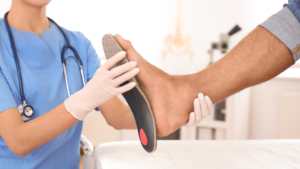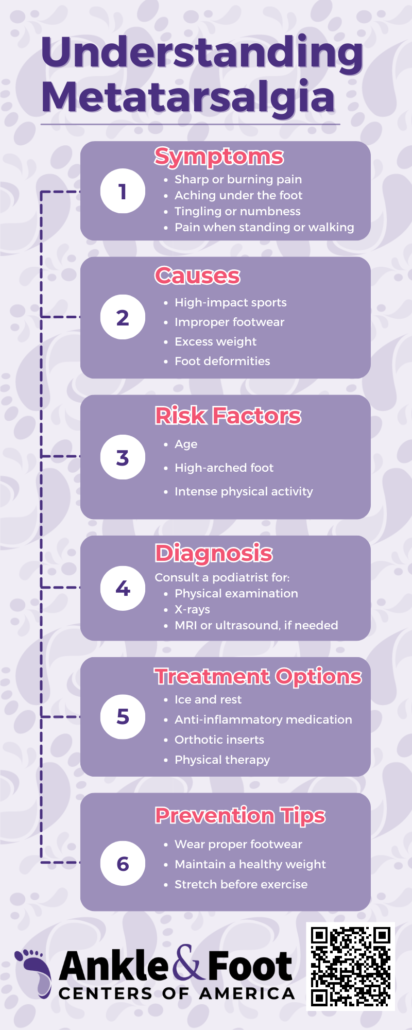Are you struggling with persistent pain and inflammation in high arch and the ball of your foot? It might be metatarsalgia, a distressing condition that can have serious impacts on daily life. To gain control over this disorder, it’s important to understand its causes, indicators and metatarsalgia treatment solutions.
In this comprehensive manual we’ll explore every aspect related to metatarsalgia including anatomy of the feet, potential risks factors associated as well as various curing options available such as home remedies or professional advice from Dr Richard Kaufman. An expert podiatrist experienced at treating cases like yours.
Table of Contents
Key Takeaways
 Metatarsalgia is a condition associated with pain and inflammation in the ball of the foot caused by physical activities, poor footwear, high heels etc.
Metatarsalgia is a condition associated with pain and inflammation in the ball of the foot caused by physical activities, poor footwear, high heels etc.- Symptoms include pain in the ball of the foot, numbness/tingling in toes. Diagnosis involves assessing symptoms & imaging tests such as X-rays/MRIs.
- Treatment options involve using appropriate footwear & shock absorbing insoles. Exercises and stretches can also provide relief from symptoms.
Understanding Metatarsalgia
The ball of the foot is susceptible to pain and inflammation if there is too much pressure applied, such as during physical activities or when wearing inappropriate shoes. If foot problems are left untreated, metatarsalgia can spread beyond the affected area resulting in aches across other parts of one’s body, like lower back and hips due to altered walking patterns induced by this particular type of discomfort. Individuals involved in high impact sports are particularly prone to these types injuries around their feet while understanding basic anatomy linked with them plays an essential part for both effective treatment plan creation as well its prevention.

Anatomy of the Foot
The feet have a complex composition which consists of 26 bones, 30 joints and more than 100 muscles, tendons as well as ligaments. The metatarsals – long bones located in the anterior part of the foot situated below toes – specifically can suffer from inflammation if exposed to too much pressure on their heads known as Metatarsal Heads. As for toe balance and stability play an important role so it is mandatory in ensuring correct functioning of this body part.
Differences among different kinds of feet could also affect distribution within force points which may lead to having metatarsalgia. Wearing suitable shoes that provide arch supports along with avoiding using high heels will be essential not just for reducing stress levels but preventing any painful situations caused by these conditions.
Causes of Metatarsalgia
Metatarsalgia is a painful condition of the metatarsal bones and can be caused by different activities, as well as footwear that create excessive pressure on the ball of your foot. Wearing high heels or being overweight also increase chances for this issue to occur. Rheumatoid arthritis, osteoarthritis, gout and stress fractures are conditions which might potentially lead to metatarsalgia too.
Any activity capable of exerting significant force onto one’s feet (such as running) needs to be done carefully in order not cause an inflammation around our precious bones. Whereas discomfort may also signal underlying medical problems requiring treatment from experts with knowledge about rheumatic disorders like mentioned earlier aforementioned diseases or else do some damage over time if neglected without professional advice.
Identifying Symptoms
Pain in the ball of one’s foot that feels like shooting or burning, as well as any numbness and tingling in toes is considered a symptom of metatarsalgia. If this pain does not dissipate even after changing footwear or activity levels, an appointment with a medical professional should be made soon to receive proper treatment before complications arise such as hammertoes, altered gait and discomfort throughout other parts of the body – lower back & hips from compensatory changes while walking. Not addressing these symptoms at once can result in prolonged healing time so seeking advice promptly will help avoid worse situations down the line.
Recognizing Risk Factors
Due to an increase in body weight shifting during movement, physical activity can contribute to the risk of metatarsalgia. Losing excess pounds is key for reducing this potential issue as heavy bodies lead to Pressure on the feet resulting in discomfort and pain. There are some genetic conditions that may also raise susceptibility towards developing it too if they cause heightened pressure when walking/running. Proper footwear such as using metatarsal pads within them can help alleviate symptoms substantially.

Prevention and Home Remedies
 To avoid metatarsalgia, it’s important to take some preventive measures such as wearing the proper footwear and shock absorbing insoles, taking rest days and stretching. Applying ice can help relieve pain caused by this condition. Orthotics are also helpful in preventing issues related to numbness or tingling around the area affected with metatarsalgia symptoms.
To avoid metatarsalgia, it’s important to take some preventive measures such as wearing the proper footwear and shock absorbing insoles, taking rest days and stretching. Applying ice can help relieve pain caused by this condition. Orthotics are also helpful in preventing issues related to numbness or tingling around the area affected with metatarsalgia symptoms.
At home remedies exist too for treating these types of pains. One is pressure bandages used along anti-inflammatories which together help alleviate any kind of soreness that may result from having problems connected with tender feet like aching joints etcetera due to lack of comfort when standing or walking at long periods during daytimes . On top of those two helps an application using cold temperatures eases sensations significantly reducing inflammation giving more balance on weight distribution felt between body parts providing better posture stability.
Diagnosis Process
Pain in the foot may be diagnosed as metatarsalgia after evaluating symptoms, examining toe bones and conducting imaging tests such as X-rays or MRI scans. To more accurately identify this condition, your doctor can ask questions about how you have been feeling recently plus details concerning any discomfort around the ball of your foot area particularly if it is a burning pain sensation felt there. A stress fracture could also cause similar pains so ruling that out first before confirming with a diagnosis for metatarsalgia would be essential.
Treatment Options
 When metatarsal pain occurs, lifestyle changes and home remedies can be effective in relieving the discomfort associated with this condition. Wearing supportive footwear, using orthotics to improve foot alignment, as well avoiding activities that put pressure on the ball of the feet all help reduce swelling and irritation. If these conservative treatments do not offer sufficient relief for metatarsalgia sufferers Surgery may become necessary. It is used to reshape bones affected by hammertoe or claw toe conditions while also easing off trapped nerves causing discomforts. Unaddressed metatarsal pain could lead to other areas of aching such as one’s lower back or hips becoming sore too, which would require more specific treatment options around alleviating distress from causes related directly to Metatarsalgia itself.
When metatarsal pain occurs, lifestyle changes and home remedies can be effective in relieving the discomfort associated with this condition. Wearing supportive footwear, using orthotics to improve foot alignment, as well avoiding activities that put pressure on the ball of the feet all help reduce swelling and irritation. If these conservative treatments do not offer sufficient relief for metatarsalgia sufferers Surgery may become necessary. It is used to reshape bones affected by hammertoe or claw toe conditions while also easing off trapped nerves causing discomforts. Unaddressed metatarsal pain could lead to other areas of aching such as one’s lower back or hips becoming sore too, which would require more specific treatment options around alleviating distress from causes related directly to Metatarsalgia itself.
Exercises and Stretches
For those with metatarsalgia, exercises and stretches may help to reduce the severity of symptoms as well as prevent worsening of the condition. Toes raises, calf stretches and stretching out your toes are effective ways to strengthen muscles surrounding metatarsal bones. It is important That you consult a physician first before starting any exercise regime so as to ensure its safety for yourself. The advantages you can get by regularly exercising include improved foot strength, increased flexibility, improved overall function of feet which subsequently alleviates pain related issues associated with Metatarsalgia while also aiding in recovery time from it too!
Alternative Causes of Ball of Foot Pain
 Foot pain in the ball of foot area can have multiple causes, so it is important to rule out alternative sources before diagnosing metatarsalgia. Pressure on this region as well as inflammation, arthritis and diabetes are all potential triggers that should be considered during a comprehensive diagnosis process. A thorough evaluation must be conducted for an effective treatment plan since some conditions may exist concurrently with this type of inflammation. Establishing the exact source of discomfort in this area is essential for successful recovery from any associated issues.
Foot pain in the ball of foot area can have multiple causes, so it is important to rule out alternative sources before diagnosing metatarsalgia. Pressure on this region as well as inflammation, arthritis and diabetes are all potential triggers that should be considered during a comprehensive diagnosis process. A thorough evaluation must be conducted for an effective treatment plan since some conditions may exist concurrently with this type of inflammation. Establishing the exact source of discomfort in this area is essential for successful recovery from any associated issues.
Summary
Persistent foot pain, particularly in the area of the ball of your foot can be indicative of Metatarsalgia. Symptoms such as inflammation and discomfort associated with this condition should not go unnoticed. It is highly advisable to speak to a professional like Dr Richard Kaufman so that an accurate diagnosis and treatment plan may be provided.
Knowledgeable about potential causes and risk factors related to metatarsalgia are essential for prevention strategies along with home remedies which help alleviate symptoms promoting recovery back into an active lifestyle free from any niggling pains or discomforts.
Frequently Asked Questions
How do I treat metatarsalgia?
To treat metatarsalgia, you should raise your feet when resting, use shock-absorbing insoles or arch supports when walking, add padding to your shoes such as fleecy web, foam, felt or gel covers and use metatarsal pads or a metatarsal bar to support the foot and reduce pressure from the metatarsal bones.
Self care such as icing the affected area, taking over-the-counter pain relievers, wearing proper shoes and considering arch supports can also help relieve the symptoms of metatarsalgia.
What triggers metatarsalgia?
 Metatarsalgia is a condition resulting from strenuous activities such as running, jumping and wearing either tight or loose shoes. It can also be caused by medical issues like rheumatoid arthritis, osteoarthritis and gout, foot deformities, as well as extra body weight. High impact sports may cause metatarsalgia due to irregular muscle or bone composition which includes having an abnormally short first metatarsal bone or elongated second one.
Metatarsalgia is a condition resulting from strenuous activities such as running, jumping and wearing either tight or loose shoes. It can also be caused by medical issues like rheumatoid arthritis, osteoarthritis and gout, foot deformities, as well as extra body weight. High impact sports may cause metatarsalgia due to irregular muscle or bone composition which includes having an abnormally short first metatarsal bone or elongated second one.
What does metatarsalgia feel like?
Metatarsalgia can be felt as a sharp, aching or burning pain in the ball of the foot, located between the toes and arch underneath the metatarsal bones. This pain may worsen when standing, running, flexing the feet or walking, particularly without shoes on a hard surface, and can be accompanied by numbness, tingling or shooting pain in the toes.
Does metatarsalgia ever go away?
Depending on the nature of metatarsalgia and its seriousness, it can be effectively treated with an appropriate approach. Offering a possibility to have relief from this condition.
What is metatarsalgia?
Pain in the ball of the foot, known as metatarsalgia, is frequently caused by activities involving too much pressure on this area of the body or due to deformities within that part of a person’s feet. It may also be induced from wearing inadequate shoes.






